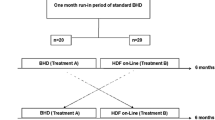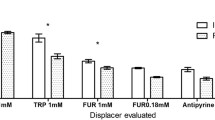Abstract
Standard dialysis did not result in a decrease of the OTA level in the blood serum of patients regularly treated by dialysis. Therefore, we examined the effect of dialysis on both OTA bound to the blood plasma proteins and free OTA. We carried out an in vivo experiment to determine OTA levels in the serum of patients in the terminal stage of chronic renal insufficiency (CHRI) before and after dialysis and also in the dialysate in which we did not find OTA. OTA bound to blood plasma proteins did not penetrate the dialysis membrane. In contrast, free OTA during an in vitro experiment with the identical dialyzer (as during the in vivo experiment), easily penetrated the same dialysis membrane.
Zusammenfassung
Die Standarddialyse führte nicht zur Senkung der Konzentrationen von Ochratoxin A im Blutserum bei Patienten, die regelmäßig durch Dialyse behandelt wurden. Demzufolge haben wir die Dialysewirkung sowohl auf Ochratoxin A, gebunden auf plasmatische Blutproteine, als auch auf freies Ochratoxin A, untersucht. Wir haben einen Versuch in vivo durchgeführt mit dem Zweck, die Mengen von OTA im Serum der Patienten in der Schlussphase der chronischen renalen Isuffizienz vor und nach der Dialyse festzustellen, jedoch ebenfalls im Dialysat, in dem wir OTA nicht festgestellt haben. OTA, gebunden an plasmatische Proteine, drang nicht durch die Dialysemembran. Andererseits, das freie OTA in dem in vitro Versuch mit einem identischen Dialysator /wie bei dem in vivo Versuch/ durchdrang ohne Schwierigkeiten die gleiche Dialysemembran.
Similar content being viewed by others
References
Bauer J, Gareis M (1987) Ochratoxin A in der Nahrungsmittelkette. J Vet Med. 34: 613–627
Creppy EE, Betbeder AM, Gharbi A, Counord J, Castegnaro M, Bartsch H, Moncharmont P, Fouillet B, Chambon P, Dirheimer G (1991) Human ochratoxicosis in France. In: Mycotoxins, Endemic Nephropathy and Urinary Tract Tumours, IARC, Lyon, 115: 145–151
Atelier de Travail International sur l’Ochratoxine A (UNESCO, FAO, IUPAC, ICSU) (1995) Recueil de protocoles pour l’analyse de l’ochratoxine A. Tunisie, Sousse, Faculté de Médecine, November 14–17: 1–28
Hagelberg S, Hult K, Fuchs R (1989) Toxicokinetics of Ochratoxin A in several species and its plasma — binding properties. J. Appl. Toxicol. 9: 91–96
Galtier P, Charpenteau JL, Alvinerie M, Labouche C (1979) The pharma-cokinetic profiles of Ochratoxin A in the rat after oral and intravenous administration. Drug Metabol. Dispos. 7: 429–434
Stojkovic R, Hult K, Gamulin S, Plestina R (1984) High affinity binding of Ochratoxin A to plasma constituents. Biochem. Int. 9: 33–38
Author information
Authors and Affiliations
Rights and permissions
About this article
Cite this article
Malir, F., Severa, J., Roubal, T. et al. The dialysis of Ochratoxin A (OTA). Mycotox Res 17 (Suppl 2), 129–131 (2001). https://doi.org/10.1007/BF03036420
Issue Date:
DOI: https://doi.org/10.1007/BF03036420




